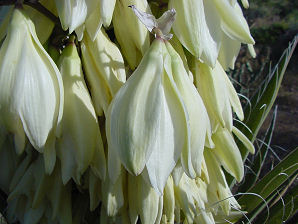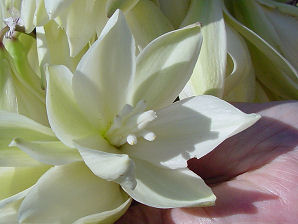Arizona Wild Flowers
Pictures, Photos, Images
Descriptions, Information, Reviews.
Banana Yucca, Yucca baccata.
We Are Proud Of Our SafeSurf Rating!
Click On Any Of The Following Links By Amazon.Com
For Books, & Videos About Wildflowers Of Arizona & The Southwest USA. No Obligation!
 |
| Banana Yucca, Yucca baccata. Photo Taken March 16, 2005 Saguaro Lake, Arizona. |
|---|
 |  |
| Banana Yucca, Yucca baccata. | Banana Yucca, Yucca baccata. |
|---|---|
 |  |
| Banana Yucca, Yucca baccata. | Banana Yucca, Yucca baccata. |
 /
/

Banana Yucca.
We wish to thank Wikipedia, the free encyclopedia for some of the information on this page. We share images and information with Wikipedia. Yucca baccata (Datil yucca or Banana yucca) is a common species of yucca native to the deserts of the southwestern United States and northwestern Mexico. It gets its name from its banana-shaped fruit. Banana Yucca is known to live in the Great Basin, the Mojave, Sonoran, and Chihuahuan Deserts, in the states of Utah, California, Nevada, Arizona, Colorado, New Mexico, and Texas in the United States, and the state of Chihuahua in Mexico. Banana Yucca can be found in several different habitat types, including Pinyon-Juniper, Sagebrush, and Ponderosa pine colonies at elevations generally between 4,900 - 7,375 feet. It is associated with Yucca schidigera, Yucca brevifolia, Yucca arizonica, Yucca faxoniana, Agave utahensis, and other Agave species. It can be found among Sclerocactus, Pediocactus, Navajoa, and Toumeya species. Yucca baccata occurs in a large area of the North American deserts and exhibits much variation across its range. Yucca baccata specimensgrowing in the higher, mountainous regions of the Rocky Mountains are winterhardy and they tolerate extreme cold conditions. Yucca baccata usually forms a single evergreen clump about 3 - 6 feet high which can sometimes form multiple heads. It's banana shaped fruit is edible & has been used by the native people of the southwestern USA, & Mexico. Other species of Yucca are also used by native people in Central America, & South America. George & Eve DeLange have eaten Yucca in South America, and it is not too bad! The leaves were used by native Americans to make baskets, sandals, and mats. Banana Yucca (as well as other yuccas) rely on the female Pronuba Moth for pollination. No other pollinator can transfer the pollen from one flower to another. The female Yucca Moth has evolved special organs which collect and distribute the pollen onto the surface of the flower. The moth then lays her eggs in the flowers' ovaries, and when the larvae hatch, they feed upon the yucca seeds. Without this moth, the Banana Yucca could not reproduce, nor could the moth, whose larvae need the seeds to eat. An old Banana Yucca can sprout new plants from its roots, however only the seeds produced by pollinated flowers can scatter far enough away from the old plant to establish a new stand of plants. Yucca baccata was in the Aguave Family but now is in the Lilly Family.
Quick Notes:
Height: About 3 - 6 feet spreading out to about 3 - 10 foot wide.
Flowers: he waxy, bell-shaped flowers are very narrow and usually white or greenish, sometimes reddish in color. They are on a spike held 2 - 3 feet above the main clump. They hang down like a bunch of banana.
Flowering Time: April - May.
Stem: They may form a small 2 - 5 foot trunk, Gets larger as it ages.
Fruit: T4 - 6 inches long, shaped like a banana; edible.
Leaves: The leaves have long slender points; curved or U-shaped across the blade width; a rough texture; with small threads on the margins; and the points on the leaf ends. They are basal rosette.
Found: According to the USDA it is native to the USA (AZ, CA, CO, NM, NV, TX, UT) Native to the Sonoran Desert. Also found in Northern Mexico in northern Sonora, northern Chihuahua, Baja Norte, Baja California, & Coahuila.
Hardiness:
Soil pH requirements:
Sun Exposure:
Elevation: 4,900 - 7,375 Feet.
Habitat: On dry hills and flats throughout the Sonoran Desert. It especially likes dry washes between dry hills.
Miscellaneous: Flowering Photos Taken March 16, 2005. Near Saguaro Lake, in Arizona.
|
We Are Proud Of Our SafeSurf Rating!



We Are Proud Of Our SafeSurf Rating!
Click On Any Of The Following Links By Amazon.Com
For Books, & Videos About Xerioscape Plants Of Arizona & The Southwest USA. No Obligation!
Back To Arizona Wild Flowers Home Page.
Back To Arizona Wild Flowers, Cream - White Flowers Page Two.
Back To Arizona Xeriscape Landscaping Main Page.
Back To Xeriscape Succulents Page One.
Back To DeLange Home Page
© 1966 - Present, Audrey, Eve, & George DeLange
| © 1966 - Present, Audrey, Eve, & George DeLange |


